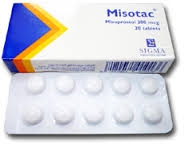
Misotac tablets
Composition:
Each tablet contains:
Active ingredient:
Misoprostol 200mcg
inactive ingfadients:
Croscarmellose sodiun, Aerosil200, microcrystalline cellulose.
Pharmaceutical form:
Tablets
Pharmacological action:
Misotac is an analogue of I’\8luraUy occurring prostaglandin E1 which promotes peptic ulcer healing symptomatic relief.
Misobc protects the gastroduodenal mucosa by inhibiting basal, stimulated and nocturnal acid S8CI’1 reducing the YOIume of gastric secretions, the prol8olytic activity of the gastric fluid, and increasing and mucus secretion.
Pharmacokinetics:
Misotac is rapidly absorbed fclIrJwng oral administration, with peak plasma Ievets of the active rneta (rrisoprostoI acid) occurring after about 30 mtnutes. The plasma elimination half-life of misoprostoI8I minutes. No aocumutation of misoprostoI acid in plasma oc:om after repeated dosing of 400 mic:roor daily.
Indications:
Misotac Is Indicated for the healing of duodenal ulcer and gastric ulcer including those induced by ne anti-inftammatol’y drugs (NSAlD) In arthritic patients at risk, whilst continuing their NSAIO thefapy. In Misotac can be used for the prophylaxis of NSAID-induced ulcers.
Dosage and administration:
Used under medical supervision
adults :
Healing of duodenal ulcer, gastric: ulcer and NSAID-1nduced peptic ule«: 800 miaograms daily four divided doses taXen with breakfast and I or each main meal and at bedtime. Treatment should be given initially for at least 4 weeks even if symptomatic relief has been achieved most patients ulce~ will be healed in 4 weeas but treatmeot may be continued for up to 8 weeks if re- ulcer relapses further treatment courses may be given. Prophylaxis of NSAlD-Induced peptic ulcer: 200 micrograms twice daily. three limes daily Of four I Treatment can be requir& drDo.age 6houId be individua~sed.according to the clinical condieione of each patient
Elderly
The usual dosage may be used.
RenaJ~’ AvUabIe evidence n:ticates that no adjustment of dosage is necessaty in patienb inpainnenl Hepatic impairment: Misotac is metabolised by fatty acid oxidising systems present in organs thmugI” body. Its metabolism and plasma levels are therefore unlikely to be affected markedly in patients with
impairment
Children
Use of Misotac In children has not yet been evaluated In the treatment of peptic ulceration or NSAID peptic ulcer disease
Contraindications:
Misotac is contraindicated in patients with a known allergy to prostaglandins.
Side effects:
Gastroinfestina/ system: Diarrhea has been reported and is occasionally severe and prolonged and may require withdrawal of the drug. It can be minimised by using single doses not eKceeding 200 micrograms with food and by aVOiding the use of predominantly magnesium containing antacids when an antacid is required.
Abdominal pain with or without associated dyspepsia or dlarrhea can follow misoprostol therapy. Other gastrointestinal adverse effects reported indude dyspepsia, natulence, nausea and vomiting. Female reproductive system: Menormagia, vaginal bleeding and Intermenstrual bleeding have been reported in
cee-eoo post-menopausal women. Other side effects: Skin rashes have been reported. Dizziness has been infrequently repoI1ed.
The pattem of side effects associated with Mlsotac Is similar when an NSAID is given concomitantly. A number 01 side effects have been reported in dinical studies or in the literature following use 01 misoprostol for non-approved Indications. These include: Abnormal uterine cootractions, uterine haemormage, retained placenta, amniotic nuid embolism, Incomplete abortion and premature birth.
Drug Interactions:
Misotac is predominantly metabolised via latty acid oKidising systems and has shown no adverse effect on the hepatic microsomal mixed function cxcase (P450) enzyme system. In specific studies no dinicaJly significant pharmacokinetic interaction has been demonstrated with antipyrine, diazepam and propran01oi. In extensive dinical studies no drug interactions have been attributed to MIsotac. Additional evidence shoYls no dinicaUy important pharmacokinetic or pharmacodynamic interaction with nonsteroidal anli-innammatory drugs including
aspirin, didolenacand ibuprofen.
Pregnancy and lactation:
Pregnancy: Mlsotac is contraindicated in pregnant women and in women planning a pregnancy as it jncreeses uterine tone and cootractions In pregnancy whid1 may cause partial or complete eICpulsion 01 the products of conception. Use in pregnancy has been associated with birth defects.
Lactation:lt is not knoYlfl if the active metabolite of Misotac is excreted in breast mWk; therefore Mlsotac should not be administered during breast leeding.
Precautions and warnings:
Not to be used except under medical supervision
– Use in pre-menopausal women: Mlsotac should not be used in pre-menopausaJ women unless the patient requires nonsteroidal anti-innammatory (NSAID) therapy and is at high risk of complications from NSAJO-induoed ulceration. In such patients it is advised that Misotac should only be used if the patient:
* takes effective contraceptive measures
* has been advised of the risks of taking Misotac if pl'”egnant
If pregnancy is suspected the product should be discontinued.
– The results of dinical studies indicate that MJsotac does not produce hypotension at dosages effective in promoting the healing of gastric and duodenal ulcers. Nevertheless, Mlsotac should be used with caution in the presence 01 disease states where hypotension might precipitate severe complications, e.g .. cerebrovascular
disease, coronary artery disease or severe peripheral vascular disease induding hypertension.
– There is no evidence that Mlsotac has adverse effects on glucose metabolism in human volunteers or patients with diabetes mellitus
Patient instructions:
Keep out of reach of children.
Package and storage:
A box cootaining one or two At ,At blisters each of 10 tablets
Store in dry place at temperature not exceeding 3O”C.
Produced by:
SIGMA Pharmaceutical Industries – Egypt – S.A.E.
